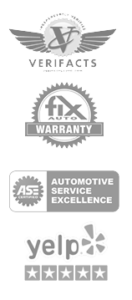The Dangers Of Speeding
December 13th, 2020 by Eli P

We all know it’s not safe, or legal, to speed behind the wheel. Yet, many drivers do it anyway, often without even realizing they are speeding.
Driving way too fast increases the likelihood of a collision with motorists, pedestrians, or objects. But, every driver can do their part to follow the speed limit. In doing so, each driver can reduce the number of speeding accidents nationwide.
Why Do Drivers Speed?
Research into speeding shows that drivers tend to speed for the following reasons:
- In a hurry to reach their destination
- Not paying attention to how fast they’re going
- Don’t think speeding is dangerous
- Don’t think they will get caught
- Enjoy driving fast
What you may not know is that speeding can involve more than just driving above the posted speed limit. If you’re driving too fast for the existing traffic, weather, or road conditions, you’re speeding.
How Much Time Do I Save by Speeding?
The time saved with speeding is minimal, regardless of how often you drive or how far you travel. In fact, the time required to deal with getting pulled over by a police officer for speeding or pay off or dispute a speeding ticket can add up, long after you were penalized for the incident.
Ultimately, speeding can be problematic for drivers and pedestrians. If you are tempted to speed, you may want to reconsider why speeding is dangerous.
Stop Driving Fast! 7 Reasons Why Speeding Is Dangerous
Regardless of the reason, speeding can put everyone on the road at risk. Reasons why speeding is dangerous include:
1. Speeding is a leading cause of traffic fatalities.
Statistics show that speeding is a primary factor in 33% of all fatal automobile crashes. It’s also the third leading contributing factor in all auto crashes. And 39% of male drives age 15 to 20 were speeding at the time of their fatal auto accidents.
2. Speeding increases the risk of getting in an accident.
Speeding increases the odds of being involved in an auto accident in many ways:
- It requires a faster reaction time of the driver, as speeding cars cover more ground than a car traveling at a slower rate of speed.
- It requires a longer braking distance, for the same reason.
- Speeding also increases the risk of losing control of the vehicle.
Put all these factors together and the odds of being in a crash significantly increase.
3. Speeding affects the severity of a crash.
It’s a simple law of physics. Cars traveling faster have more kinetic energy, so when they slam into something, the damage to the vehicles and people in them is more severe.
4. Speeding can lead to other unsafe driving habits.
Studies show that frequent speeders are more likely to engage in other risky driving behaviors such as tailgating, unsafe lane changes, and running red lights.
5. Speeding causes economic damage to society.
The U.S. National Highway Traffic Safety Administration estimates that auto accidents cost more than $1 trillion dollars a year. This includes $277 billion in actual cost, and an estimated $594 billion in “harm from the loss of life and the pain and decreased quality of life due to injuries.” As the third leading cause of accidents, that means speeding is directly responsible for more than $333 billion dollars in damage every year.
6. Speeding can drain your bank account.
If you get caught speeding, the financial penalties can put a real dent in your wallet. Depending on how fast you’re going over the speed limit, first time offenses start at several hundred dollars and can go much higher. Repeated speeding offenses will lead to more severe penalties, including loss of your license.
7. Speeding can harm the environment.
Speeding is bad for the environment, due to the fact that driving at high speeds requires you to use more fuel, which puts more carbon emissions into the atmosphere.
Speeding Advice: Tips to Help You Follow the Speed Limit
If you want to avoid speeding, you can:
1. Use Cruise Control
If your car has cruise control, take advantage. Cruise control lets you set how fast your car travels, so it can help reduce the risk of speeding.
Of course, if you use cruise control, you still need to watch the road closely as you drive. If you need to deactivate your cruise control, press down on the brake pedal, and you always reset the cruise control as needed.
2. Depart Early
If you find yourself constantly rushing to get from point A to point B, give yourself extra time for travel. This may help you feel less pressure as you drive — and can help you resist the urge to speed.
It can be beneficial to check local weather and traffic reports before you depart for a destination, too. With these reports, you can find out how weather and traffic conditions may impact your ability to reach your final destination on schedule. You can then use weather and traffic insights to determine how much time you’ll need to reach your final destination on schedule.
3. Drive at a Speed Below the Limit
If you are concerned that you’ll inadvertently exceed the speed limit, try to travel below it. You can drive about 5 mph less than the speed limit to keep with the flow of traffic. At the same time, you can avoid the risk of getting pulled over for speeding.
When driving below the speed limit, you should still continue to comply with warning signs and signals. Also, try to keep your car moving close to the speed limit, as driving too slow can put you and other motorists in danger.
4. Remember the Consequences of Speeding
It only takes a second to cause a fatal car accident, particularly if you are speeding. If you understand the ramifications of speeding, you can do the right thing for yourself and others: follow the rules of the road and prioritize safety any time you drive.
Let’s not forget about the financial implications of speeding, either. If you speed, you may receive a speeding ticket, and your insurance premium may increase as well. On the other hand, if you comply with the speed limit, you can practice safe driving and avoid costly fines and penalties.
What to Do If You Are Involved in a Speeding Accident
If you are speeding and cause a car accident, ensure you and all other parties involved in the incident are safe. Call 911 if any injuries occurred and notify the police about the accident. You should also capture photographs of any damage to your car or the other motorist’s.
Lastly, if your car’s bumper, fender, or other exterior components were damaged during a speeding accident, contact Fix Auto. Our auto body technicians can evaluate your car’s exterior and perform any repairs upon request. To find out more or to schedule a service appointment, please contact us online or call us today at 800.INFO.FIX.
This blog post was contributed by Fix Auto Stockton, a leading industry expert and collision repair shop servicing Stockton.
Welcome to
Fix Auto USA
We are the premier independent body shop network delivering world-class customer service and high-quality collision repairs across the U.S.
Learn About Us





